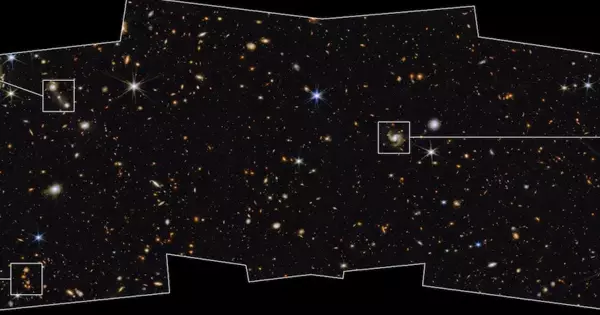The Hubble Space Telescope and ground-based telescopes have provided us with breathtaking images of galaxies for decades. This all changed in December 2021, when the James Webb Space Telescope (JWST) launched and successfully completed commissioning in the first half of 2022. For astronomers, the universe as we knew it is now revealed in a way never before imagined by the telescope’s Near-Infrared Camera (NIRCam).
Webb’s primary imager is the NIRCam, which covers the infrared wavelength range of 0.6 to 5 microns. NIRCam detects light from newly formed stars and galaxies, as well as the population of stars in nearby galaxies and young stars in the Milky Way and Kuiper Belt objects.
PEARLS, or Prime Extragalactic Areas for Reionization and Lensing Science, is the subject of a recent study published in Astronomical Journal by a team of researchers led by Arizona State University School of Earth and Space Exploration Regents Professor Rogier Windhorst, Research Scientist Rolf Jansen, Research Scientist Seth Cohen, Research Assistant Jake Summers, and Graduate Associate Rosalia O’Brien, with contributions from many other researchers.
Webb’s images are truly phenomenal, really beyond my wildest dreams. They allow us to measure the number density of galaxies shining to very faint infrared limits and the total amount of light they produce. This light is much dimmer than the very dark infrared sky measured between those galaxies.
Rogier Windhorst
The images of the earliest galaxies in the PEARLS program show the amount of gravitational lensing of objects in the background of massive clusters of galaxies, allowing the team to see some of these very distant objects. The team used stunning multicolor images to identify interacting galaxies with active nuclei in one of these relatively deep fields.
Windhorst and his team’s data show evidence for giant black holes in their center where you can see the accretion disc – the stuff falling into the black hole, shining very brightly in the galaxy center. Plus, lots of galactic stars show up like drops on your car’s windshields – like you’re driving through intergalactic space. This colorful field is straight up from the ecliptic plane, the plane in which the Earth and the moon, and all the other planets, orbit around the sun.
“For over two decades, I’ve worked with a large international team of scientists to prepare our Webb science program,” Windhorst said. “Webb’s images are truly phenomenal, really beyond my wildest dreams. They allow us to measure the number density of galaxies shining to very faint infrared limits and the total amount of light they produce. This light is much dimmer than the very dark infrared sky measured between those galaxies.”

The first thing the team can see in these new images is that many galaxies that were next to or truly invisible to Hubble are bright in the images taken by Webb. These galaxies are so far away that the light emitted by stars has been stretched.
The team used the Webb telescope to study the time domain field of the North Ecliptic Pole, which is easily visible due to its location in the sky. Windhorst and his team intend to observe it four times. The first observations, consisting of two overlapping tiles, produced an image that shows objects as faint as the brightness of ten fireflies at the moon’s distance (with the moon not there). Webb’s absolute limit is one or two fireflies. The faintest reddest objects visible in the image are distant galaxies dating back to the first few hundred million years after the Big Bang.
For most of Jansen’s career, he’s worked with cameras on the ground and in space, where you have a single instrument with a single camera that produces one image. Now scientists have an instrument that has not just one detector or one image coming out of it, but 10 simultaneously. For every exposure, NIRCam takes, it gives 10 of these images. That’s a massive amount of data, and the sheer volume can be overwhelming.
Summers has been instrumental in processing that data and channeling it through the analysis software of collaborators all over the world. “The JWST images far exceeded our expectations based on my simulations prior to the first science observations,” Summers said. “I was most surprised by the exquisite resolution of these JWST images while analyzing them.”
Jansen’s main goal is to figure out how galaxies like our own Milky Way formed. And one way to do so is to look far back in time at how galaxies came together, how they evolved, and thus trace the path from the Big Bang to people like us.
“The first PEARLS images blew me away,” Jansen said. “I had no idea when I chose this field near the North Ecliptic Pole that it would yield such a treasure trove of distant galaxies, and that we would get direct clues about the processes by which galaxies assemble and grow – I can see streams, tails, shells, and halos of stars in their outskirts, the leftovers of their building blocks.”
O’Brien, a third-year astrophysics graduate student, devised algorithms to detect faint light between galaxies and stars that first catch our attention.
“The diffuse light that I measured in between stars and galaxies has cosmological significance, encoding the history of the universe,” O’Brien said. “I feel fortunate to start my career right now – JWST data is like nothing we have ever seen, and I’m excited about the opportunities and challenges it offers.”
















